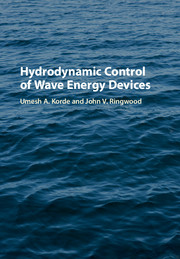Book contents
- Frontmatter
- Contents
- Preface
- Acknowledgments
- Part I Introduction
- Part II The Basics
- Part III The Hydrodynamics
- Part IV Velocity Control Using a Hydrodynamic Model
- 7 Reactive Control in Time Domain
- 8 A Causal Real-Time Controller for Wave Energy Converters
- Part V Control by Optimizing a Performance Index
- Part VI Toward Overall WEC System Hydrodynamic Optimization
- Part VII In Closing
- References
- Index
8 - A Causal Real-Time Controller for Wave Energy Converters
from Part IV - Velocity Control Using a Hydrodynamic Model
Published online by Cambridge University Press: 05 September 2016
- Frontmatter
- Contents
- Preface
- Acknowledgments
- Part I Introduction
- Part II The Basics
- Part III The Hydrodynamics
- Part IV Velocity Control Using a Hydrodynamic Model
- 7 Reactive Control in Time Domain
- 8 A Causal Real-Time Controller for Wave Energy Converters
- Part V Control by Optimizing a Performance Index
- Part VI Toward Overall WEC System Hydrodynamic Optimization
- Part VII In Closing
- References
- Index
Summary
Introduction
As documented in Chapter 7, exact real-time implementation of complex-conjugate control, due to its noncausality [66, 106], requires exact wave foreknowledge. Chapter 7 considers two approaches to using information on approaching waves: one assuming nondispersive propagation and the other using a deterministic wave prediction scheme based on a more complete propagation model. Nevertheless, the possibility of designing a control scheme that obviates the requirement for future information, may be attractive. In addition, it would be desirable if the limitations imposed by the physics of the system (e.g., amplitude of motion or velocity, applicable forces) are explicitly considered.
As considered in Chapter 9, latching control [107]–[109] presents one alternative, where the oscillation in the system is delayed so to be in phase with the excitation from the waves. While, in theory, latching allows the achievement of high energy capture, its applicability has been questioned [110] due to the excessive loads on the latching mechanism, the disappointing performance in the case of self-reacting point absorbers [111], and the long (some minutes) prediction horizon required for the real-time optimization in irregular waves to converge [107, 109]. In addition, it may be difficult to observe physical system constraints under a latching philosophy. More recent causal control schemes include that reported in [112], though physical constraints are not explicitly addressed.
Controllers that adjust the damping and stiffness coefficients of the power take-off (PTO) mechanism, in real time, have also been proposed. In [113], a fuzzy-logic controller tunes the damping based also on predictions of the incident wave elevation. However, results are not compared with latching or model predictive control (MPC) types of controllers, and the assumption of linear damping can be unrealistic with most PTOs (hydraulic in particular).
Solutions based on MPC or numerical optimization (see Chapter 10), on the other hand, have shown a lot of benefits, including the ability to handle constraints in a straightforward way [114, 134]. Such techniques, however, need to solve a constrained optimization problem at each time step, which can be time-consuming if a complex model of the (WEC) is utilized. In addition, the performance of the controller depends on a variety of variables (cost function, optimization algorithm, prediction horizon, specification of the constraints, etc.) that are not always related to the physical domain of the problem and can be tuned only by extensive simulation.
- Type
- Chapter
- Information
- Hydrodynamic Control of Wave Energy Devices , pp. 182 - 202Publisher: Cambridge University PressPrint publication year: 2016



